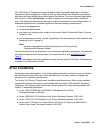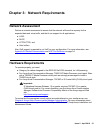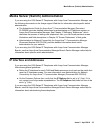
Network Requirements
26 Avaya 1600 Series IP Deskphones Administrator Guide
Note:
Note: Priority 0 is a higher priority than Priority 1.
Network Audio Quality Display on 1600 Series IP Telephones
All 1600 Series IP Telephones give the user an opportunity to monitor network audio
performance while on a call. For more information, see the telephone user guide.
While on a call, the telephones display network audio quality parameters in real-time, as shown
in Table 4
:
The implication for LAN administration depends on the values the user reports and the specific
nature of your LAN, like topology, loading, and QoS administration. This information gives the
user an idea of how network conditions affect the audio quality of the current call. Avaya
assumes you have more detailed tools available for LAN troubleshooting.
IP Address Lists and Station Number Portability
The 1600 Series IP Telephones provide the capability to specify IP address lists. On startup or a
reboot, the telephone attempts to establish communication with these various network elements
in turn. The telephone starts with the first address on the respective list. If the communication is
denied or times out, the telephone proceeds to the next address on the appropriate list and tries
that one. The telephone does not report failure unless all the addresses on a given list fail,
thereby improving the reliability of IP telephony.
Table 4: Parameters in Real-Time
Parameter Possible Values
Received Audio Coding G.711, G.711u, G.711a, G.726, G.729A, or G.729B.
Packet Loss "No data" or a percentage. Late and out-of-sequence packets
are counted as lost if they are discarded. Packets are not
counted as lost until a subsequent packet is received and the
loss confirmed by the RTP sequence number.
Packetization Delay "No data" or an integer number of milliseconds. The number
reflects the amount of delay in received audio packets, and
includes any potential delay associated with the codec.
One-way Network Delay "No data" or an integer number of milliseconds. The number is
one-half the value RTCP computes for the round-trip delay.
Network Jitter
Compensation Delay
"No data" or an integer number of milliseconds reporting the
average delay introduced by the jitter buffer of the telephone.


















